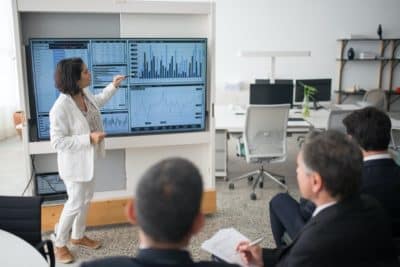Video walls are at the forefront of information distribution and have revolutionized how we approach entertainment, office work, and broadcast. Video wall systems are useful for any scenario where information must be distributed to large quantities of people. With video walls, the stress of misinformation is taken away!
At DEXON, we have a full range of video wall systems to streamline your video wall experience, so you get the most out of your setup. But what exactly is a video wall, and how do they operate? Well, we’re going to tell you.
In this article, we discuss what a video wall is, how they work and how it can become an asset to our lifestyles. So, no matter if you’re an AV genius, or the best you can do is plug in an HDMI, because we’ve got you covered. Let’s go!
IMAGE: PEXELS
What Is A Video Wall?
A video wall is a collection of screens used to display one or multiple coherent images. The resolution of the video is the sum total of the individual monitor’s screen resolution. Video walls can display one large image to create your very own movie theater experience, or isolate each monitor to revolutionize your conference room experience.
You may have seen a video wall before without even realizing it! Video walls are most prevalent in spaces where information needs to be given out to lots of people at once. An example of this is a train station where screens display train platforms, times, and destinations. Video walls allow information to be centralized to minimize confusion and miscommunication.
Video walls can be used in the following settings:
- Sports stadiums
- Offices
- Home theaters
- Transport facilities
- Museums
- Newsrooms
- Mission control centers
- Security facilities
Just for your information, the video wall market is expected to skyrocket in the next five years to almost 24.5 billion dollars’ worth in industry!
How Does It Operate?
Video walls require extensive management in order to create engaging and informative displays. Processors, matrix and different kinds of monitors all contribute to creating your perfect video wall experience.
Your choice of video wall management systems should be mostly dependent on your project requirements, as this can optimize your video wall experience. Below, we’ve listed all the essential components of a video wall and how they contribute to your experience:
Video Wall Processors
Most video wall projects require processors or controllers to process input signals and display content on any of the screens. Video processors are essential for managing large quantities of data, so the more sophisticated your AV project is, the more you will need a processor. Processors allow users to create effects, play audio and isolate individual screens to create a truly engaging display in their home, office, or entertainment facility.
LCD Panels
LCD panels are the most traditional example of a video wall and create effective displays by grouping LCD monitors together. There are some drawbacks of LCD panels as they use significant energy and have some interruption in display due to screen boundaries.
Rear Projected Cubes
Rear projected cubes integrate projection and screens to create a seamless and detailed display. They consist of multiple cubes to narrow the screen boundaries and ensure image continuity.
LED Panels
LED panels are great for displaying highly detailed bright displays for museums, shopping malls, and newsrooms. LED panels are thin and have very few boundaries, improving user experience significantly. In fact, LED panels have seen considerable growth over the last few years due to their energy efficiency and better alternative to LCD panels.
Why Should You Use Video Wall Technology?
There are many reasons why you may wish to incorporate video walls into your home or office. Below, we’ve listed lots of key benefits to using video walls:
Better Communication
Video walls improve communication by centralizing your information hub. When everyone receives the exact same information at the same time, misinterpretation and miscommunication are a thing of the past. Video walls can stream live updates, conferences, and isolate snippets of information. This boosts productivity and improves workplace relationships and job satisfaction.
Engaging
Employers may benefit from increased engagement rates with video walls. Colleagues may be more engaged in conference rooms or during their workday if their information source is bustling with exciting technology.
Video walls provide offices with their very own mission control center, so staff is bound to be pretty excited. Business Insider ranks engagement as a top priority in modern-day workplaces, so consider investing in a video wall to get ahead of the curve!
Impressive
Potential clients or investors may be impressed by a company that places itself on the leading edge of information technology. A company that markets itself as technology positive and takes communication and colleague engagement seriously may be more popular in the public eye. Impressive assets like video walls might generate a large return on investment.
Improved Security
Video walls can link up to your home security system and provide you with a full view of all entrances and exits to your building. This not only looks like something out of a spy movie, it also gives you peace of mind and places you one step ahead of any danger.
Diverse Options
Video walls come with a range of operation options. With video walls, you have the power to customize your experience by electing processors specifically designed with your needs in mind. You also have the luxury of picking your video wall solution for an optimal and seamless experience.
Great For Conferencing
Are conference calls starting to get boring? Well, video walls can help bring them back to life. With the ability to isolate screens, you can now make conference calls an interactive experience for in-person and virtual attendees.
Frequently Asked Questions
What Is A Video Wall?
A video wall is a collection of screens of varying sizes that display one or multiple coherent images. Video walls use processors and varying types of screens to create engaging displays in a variety of settings.
Why Do We Use A Video Wall?
You may use video walls in various settings like offices, education settings, entertainment, and transport. All of these settings benefit from the increased information transparency that video walls offer.
Main Reasons For Video Wall Operation
Video walls offer improved communication, engagement, impressive presentation, improved security, and unique conferencing abilities. These elements are beneficial in areas where information is distributed to large quantities of people.
IMAGE: PEXELS
If you are interested in even more technology-related articles and information from us here at Bit Rebels, then we have a lot to choose from.


COMMENTS